11 Best Native Plants for Maine
BY ANDRÉA BUTLER | MAY 14TH, 2023 | LAWN CARE, MAINEThe Vacationland is homeland to you; even still, you need not venture far to appreciate your state’s natural beauty. Inspired by the Wild Gardens of Acadia, your latest project is cultivating a bed of native plants in your own Maine landscape. To start you off on this quest, we’ve gathered 11 best native plants for Maine, just waiting to take root near you.
In this article, we’ll cover:
- 11 Native Plants for Your Maine Yard
- How to Choose Native Plants for Your Maine Yard
- FAQ About Native Maine Plants
- Where to Find Native Plants in Maine
11 Best Native Plants for Maine
1. Nannyberry (Viburnum lentago)
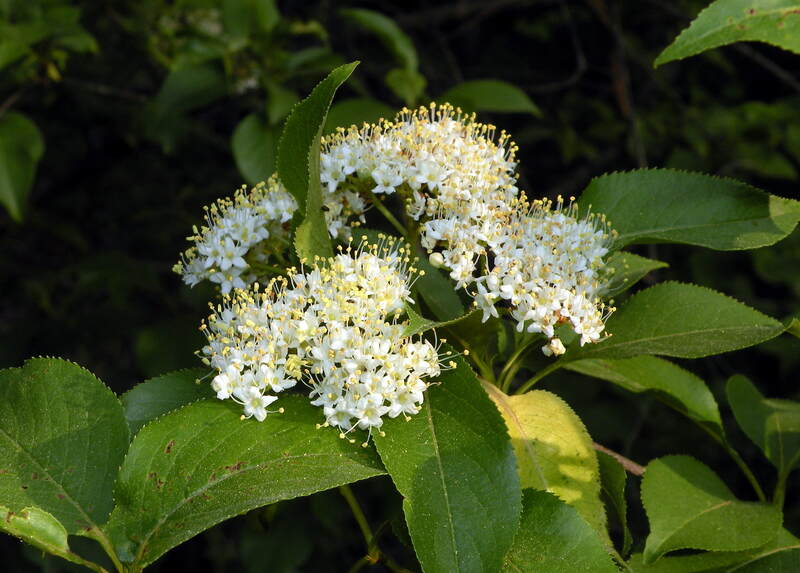
Photo Credit: Doug McGrady / Flickr / CC BY 2.0
The flashy white flowers of this perennial bloom in May, followed by an autumn to winter season of color-changing leaves and berries— leaves turn burgundy while the edible berries go from green to yellow to red to deep blue. Perfect for growing as a natural privacy screen or specimen plant, this drought- and pollution-tolerant native attracts caterpillars, moths, birds, and other pollinators but repels deer.
Plant type: Shrub or small tree
USDA hardiness zone: 2 to 8
Sun: Full sun or part shade
Soil: Clay, loam, sand, moist, well-drained soil
Duration: Perennial
Bloom Time: Early summer
Water needs: Medium
Mature height: 10 to 20 feet
Foliage: Deciduous; glossy, dark green leaves turn burgundy in fall; too much shade may cause milder
Maintenance: Medium; prune after flowering and water regularly until established; no need to fertilize
2. Pagoda Dogwood (Cornus alternifolia)
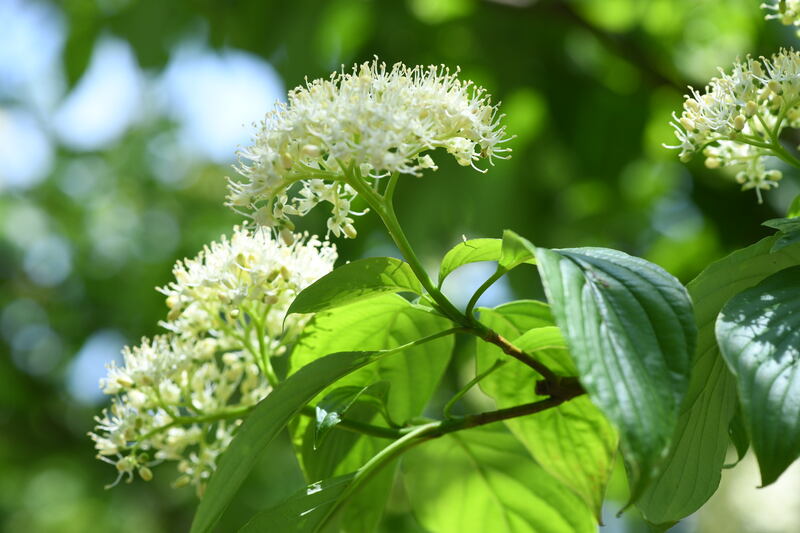
Photo Credit: Michele Dorsey Walfred / Flickr / CC BY 2.0
Named for its resemblance to a pagoda temple — its branches grow in similarly structured horizontal layers — the pagoda dogwood produces perfumed, white blooms and blue or purple berries in spring and summer, respectively. Plant it as a specimen tree, or pair it with maples, beeches, birches, or serviceberries.
Offering year–round interest, as well (the leaves turn yellow, red, and orange in autumn), this native selection is tolerant of pollution and attracts all kinds of pollinators. Keep a lookout though, as it’s susceptible to canker, twig blight, and leaf spot.
Plant type: Shrub or small tree
USDA hardiness zone: 3 to 7
Sun: Full sun or partial shade
Soil: Well-drained, nutrient-rich, acidic; sandy, loamy, clay
Duration: Perennial
Fragrance: Sweet
Bloom time: Early summer
Water needs: Low; water regularly until established and then only during drought
Mature height: 12 to 20 feet
Foliage: Deciduous; turn red, yellow, and orange in fall
Maintenance: Low
3. Common Milkweed (Asclepias syriaca)
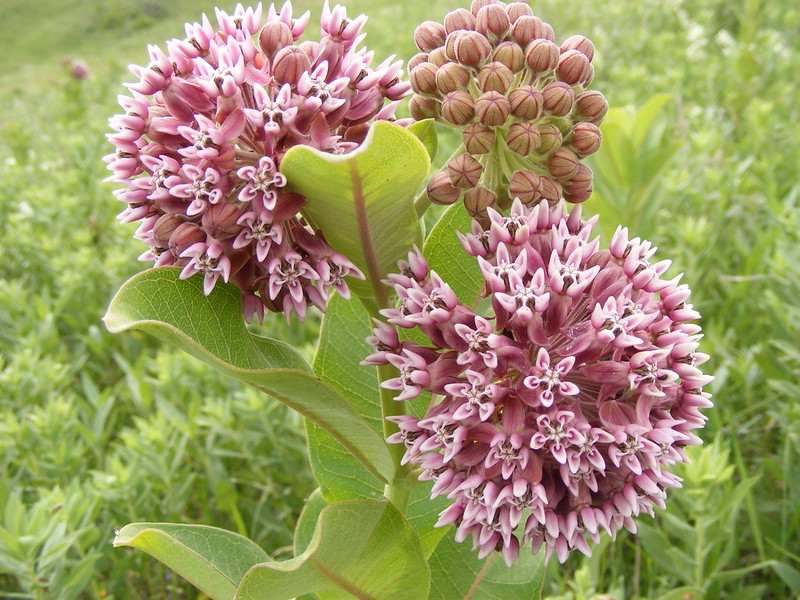
Photo Credit: USFWS Mountain-Prairie / Flickr / CC BY 2.0
As Maine is the final summer destination for monarch butterflies’ annual migration from Mexico, common milkweed is an especially important native plant that can help fight the decline of these butterflies’ populations. This native wildflower provides a place for monarchs to lay their eggs and gives off round, ball-like clusters of purple or pink flowers each summer.
Since common milkweed spreads swiftly via rhizomes, it’s best planted in naturalized areas, so it doesn’t become invasive in your traditional garden.
Plant type: Wildflower
USDA hardiness zone: 3 to 9
Sun: Full sun
Soil: Chalk, clay, loam, sand
Duration: Perennial
Fragrance: Sweetly scented
Bloom time: Summer
Water needs: Low, average
Mature height: 2 to 6 feet
Foliage: Oval, green leaves with hairy underside; release milky substance when crushed
Potential hazards: Toxic if ingested
Maintenance: Low
4. New England Aster (Aster novae-angliae)
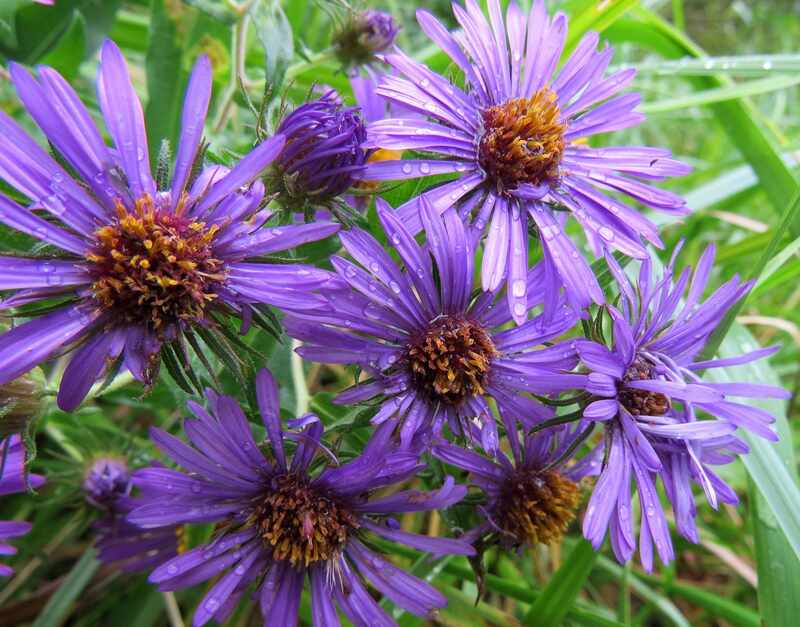
Photo Credit: USFWS Midwest Region / Flickr / Public Domain
This native selection, ideal as a garden mass planting for displays of fall color brought on by pink or purple ray flowers surrounding a yellow center, is perfect for attracting various pollinators.
Able to thrive in a range of soil types, New England aster is pretty low maintenance when it comes to water needs; it likes things moist but can tolerate some dry soils. To keep this tall-growing flower on the shorter side, prune stems in early summer. If provided the right amount of sunlight, water, and overall care, this plant can live up to 10 years.
Plant type: Flower
USDA Hardiness Zone: 4 to 8
Sun: Full sun
Soil: Well-drained, acidic, clay, sandy, loamy; poorly-drained clay soils may cause aster wilt
Duration: Perennial
Bloom time: Late summer, autumn
Water needs: Medium
Mature height: 3 to 6 feet
Foliage: Dark green leaves
Maintenance: Low; vulnerable to powdery mildew. Cut back stems in mid-summer to avoid staking and to produce more flowers.
5. Northern Bayberry (Myrica pennsylvanica)
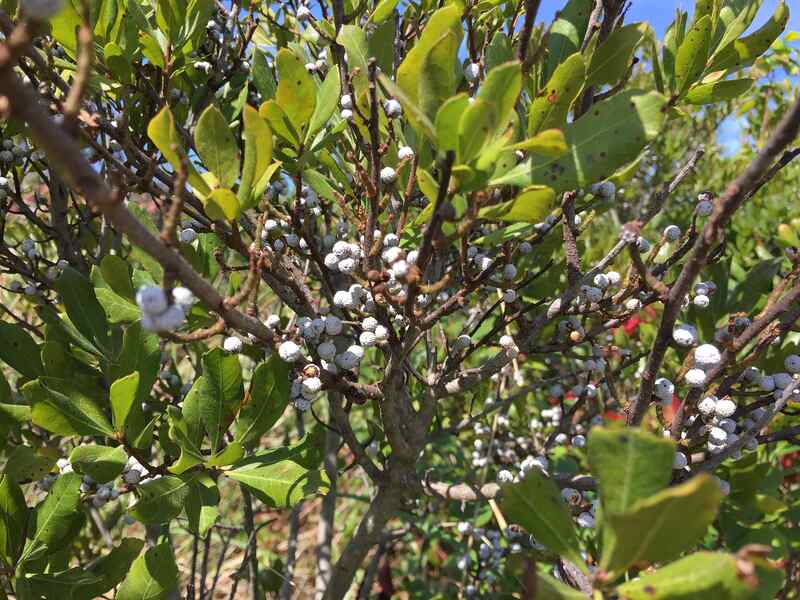
Photo Credit: Famartin / Wikimedia Commons / CC BY-SA 4.0
This wide-growing, rounded shrub generates inconspicuous gold, yellow, or green blooms in spring. Come summer and through the following spring, whitish-gray berries grow from the stems, providing a food source for birds. The fruits’ waxy finish is also used in candles and soaps.
Northern bayberry can live up to 30 years and is best used as a specimen plant, hedge, or foundation plant. It’s excellent at preventing erosion and is resistant to deer, salt, drought, heat, compacted soil, and seasonal flooding, so it’s easy for beginners to grow.
Plant type: Shrub
USDA hardiness zone: 4 to 6
Sun: Full sun
Soil: Sandy, rocky, acidic; well-drained with high organic matter
Duration: Perennial
Fragrance: Whole plant scented when crushed; peppery and woody scent
Bloom Time: Spring
Water needs: Low; water regularly until established
Mature height: 6 to 12 feet
Foliage: Deciduous to semi-evergreen; fragrant, dark green, shiny leaves
Maintenance: Low
6. Bearberry (Arctostaphylos uva-ursi)

Photo Credit: Andrew Curtis / Wikimedia Commons / CC BY-SA 2.0
Drought-tolerant, this low-growing groundcover is a prime pick for a xeriscaped yard. In mid-spring, pink, bell-shaped flowers will spring forth, while summer sees the emergence of red berries that last through fall.
Adding to the year-round interest are the dark green leaves that turn burgundy from fall through winter. This native plant, which can live up to 20 years, is also resistant to salt and pollution and can work well in an ornamental, butterfly, rock, or winter garden.
Plant type: Evergreen shrub
USDA hardiness zone: 2 to 6
Sun: Full sun or partial shade
Soil: Sandy, acidic; can be dry or moist but no standing water; susceptible to yellowing leaves if not acidic enough
Duration: Perennial
Fragrance: Autumn leaves/pine
Bloom Time: Early spring to early summer
Water needs: Low
Mature height: Up to 8 inches
Foliage: Evergreen; glossy and round, turns from green to burgundy in autumn
Potential hazards: Arbutin in foliage hinders melanin production/can lighten skin
Maintenance: Low; tolerant of drought, salt, and pollution
7. Red Columbine (Aquilegia canadensis)
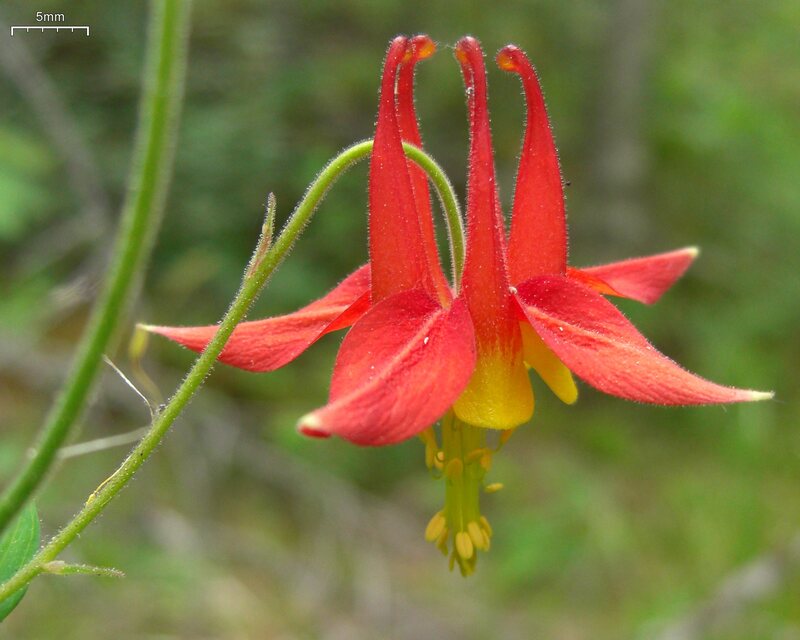
Photo Credit: Jason Hollinger / Wikimedia Commons / CC BY 2.0
From spring through summer, this perennial produces downward-hanging, umbrella-shaped blossoms that are red and yellow. Post-bloom, red columbine reseeds on its own and goes dormant as some of its leaves turn pink or purple before falling off. Although this plant has no noticeable aroma, hummingbirds, bees, and other pollinators are drawn to its nectar. Red columbine is a great accent plant for rock gardens and coastal sites, as it is salt-tolerant. Duskywing caterpillars and columbine leafminers feed on the leaves, but don’t cause any actual harm to the plant’s health.
Plant type: Flower
USDA hardiness zone: 3 to 8
Sun: Full sun or partial shade
Soil: Clay, silt, or sandy soil that’s well-drained, moist, dry-ish
Duration: Perennial
Bloom Time: Spring and summer
Water needs: Weekly or whenever soil is completely dry
Mature height: 1 to 3 feet
Foliage: Blue-green leaves grow in groups of three
Potential hazards: Moderately flammable/risk of fire
Maintenance: Low; deadhead blooms as needed, cut back in late summer
8. Northern Bush Honeysuckle (Diervilla lonicera)
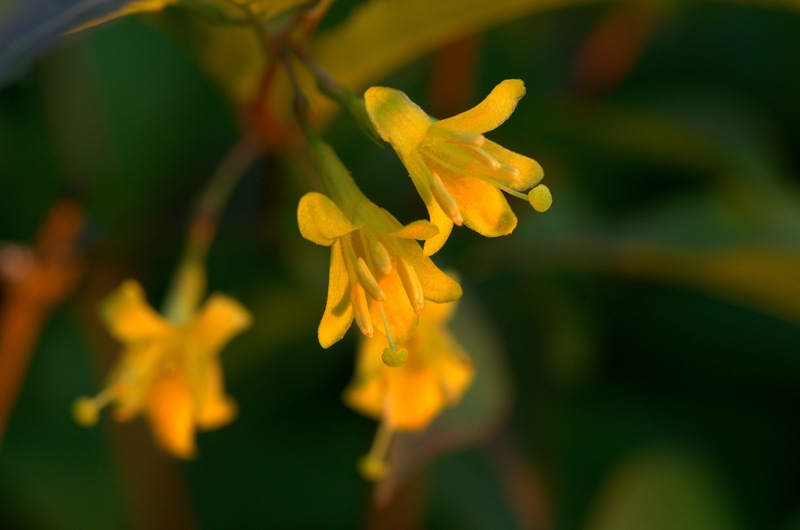
Photo Credit: Joshua Mayer / Wikimedia Commons / CC BY-SA 2.0
Unlike the nonnative, “true” honeysuckle plants, Northern bush honeysuckle is not invasive and has no scent. It does, however, have similar trumpet-shaped, yellow flowers that grow in pairs or triplets. Drought-resistant, it serves well as a privacy screen or mass planting and can endure dry and seasonally flooded conditions. Northern bush honeysuckle attracts a variety of pollinators, including bumblebees, butterflies, and hummingbirds.
Plant type: Shrub
USDA hardiness zone: 3 to 7
Sun: Full sun or partial shade
Soil: Not particular; grows in range of soil types and withstands dry and seasonally flooded soils
Duration: Perennial
Bloom Time: Summer
Water needs: Low, average
Mature height: 2 to 4 feet
Foliage: Burgundy spring new growth; pointy leaves become green and copper as they mature; turns yellow-orange or reddish-purple in fall
Potential hazards: Berries are mildly poisonous to humans.
Maintenance: Low; prune in late winter
9. Scarlet Elder (Sambucus racemosa)
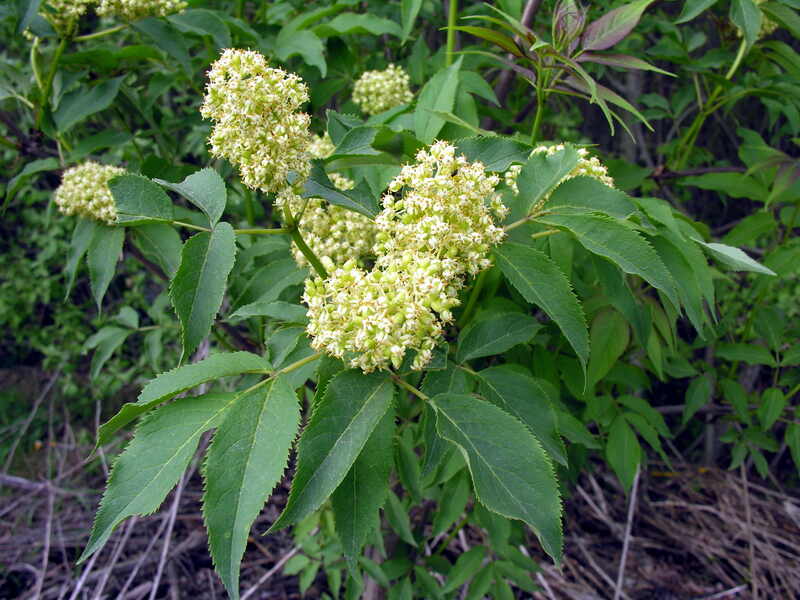
Photo Credit: Algirdas / Wikimedia Commons / CC BY-SA 3.0
Scarlet elder (aka red elderberry) produces memorable white, floral-scented, cone-shaped blooms that can thrive in wet soil, full sun, and partial shade. This plant’s calling card also includes clusters of red berries, which serve as food for several species of birds.
Naturally able to manage erosion, scarlet elder makes for a fantastic hedge when planted alongside other shrubs, like winterberry and witch hazel. It also draws its fair share of pollinators.
Plant type: Shrub
USDA hardiness zone: 3 to 7
Sun: Full sun or partial shade
Soil: Moist, well-drained soil
Duration: Perennial
Fragrance: Flowers have floral scent; leaves have unpleasant, stinky odor when crushed
Bloom Time: Spring and summer
Water needs: Medium; water well in the absence of rain
Mature height: 3 to 9 feet
Foliage: Dark green with serrated edges and hairy underside
Potential hazards: Seeds are poisonous; raw berries are toxic
Maintenance: Medium; prune to contain spread
10. Rosebay Rhododendron (Rhododendron maximum)
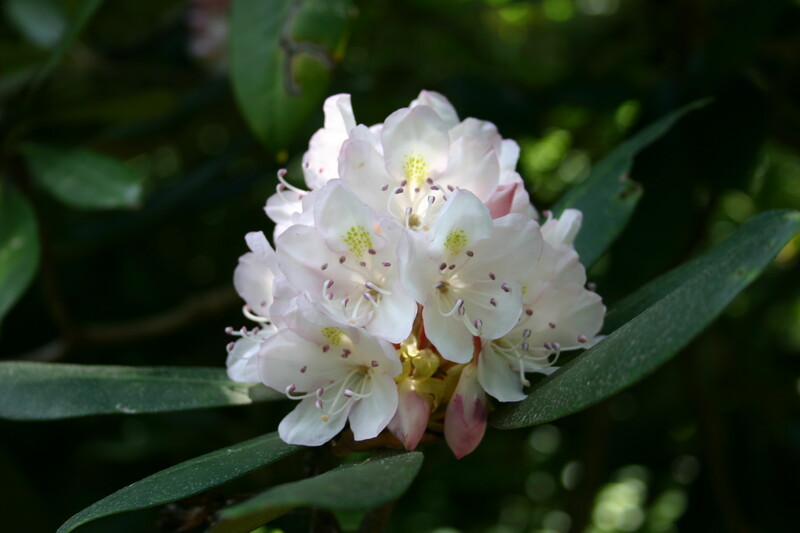
Photo Credit: SB Johnny / Wikimedia Commons / CC BY-SA 3.0
Rosebay rhododendron grows nicely in shade gardens and as border plantings underneath heavily canopied areas of hemlocks, pines, and maples. This broadleaf evergreen boasts dark, blue-green leaves that curl up to protect themselves from cold weather and prominent pink, white, or lavender flowers that grow in bell-shaped clusters.
Best as an ornamental planting in a cool, shady yard, this native perennial is not OK with drought, heat, or salt and is susceptible to canker, crown rot, root rot, powdery mildew, and leaf spot, to name a few.
Plant type: Broadleaf evergreen shrub
USDA hardiness zone: 3 to 7
Sun: Full shade or partial shade
Soil: Moist, acidic, well-drained
Duration: Perennial
Bloom Time: Summer
Water needs: Medium
Mature height: 20 to 35 feet
Foliage: Evergreen; leathery feel; dark, blue-green in color
Potential hazards: Toxic to humans, pets, horses, and other animals if ingested.
Maintenance: Medium
11. Chokecherry (Prunus virginiana)
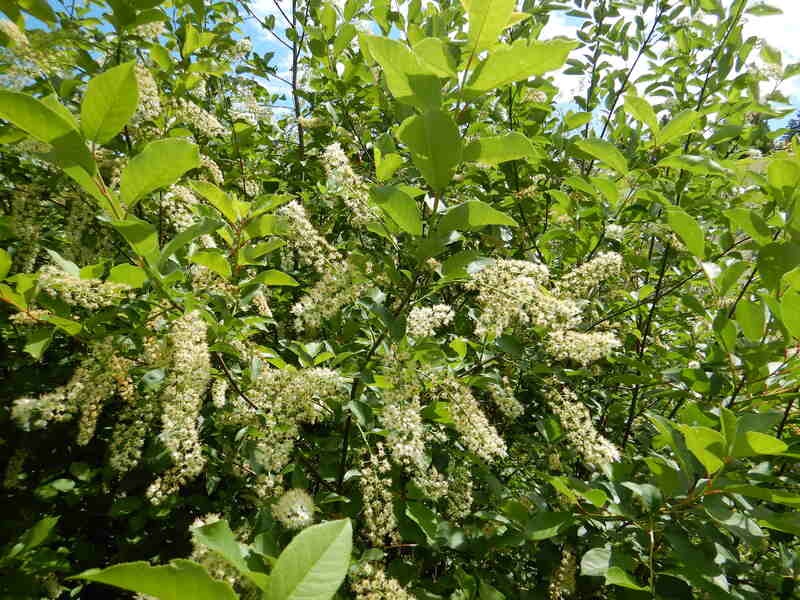
Photo Credit: Matt Lavin / Flickr / CC BY-SA 2.0
This attractive shrub, which bears white flowers, dark red berries, and green leaves, is a favorite of racoons — they love feasting on the ripened berry clusters. Also edible to humans, the fruits have been described by many as dry and “astringent.” However, taste is much improved when dried or cooked and turned into wine, jams, or jellies. Be careful not to eat the seeds, though; they are toxic. Chokecherry serves as a host to Eastern tent caterpillars, and when crushed, the twigs emit an unsavory, bittersweet smell.
Plant type: Tree
USDA Hardiness Zone: 2 to 7
Sun: Full sun to full shade
Soil: Moist, limestone-based, sand, loam, clay
Duration: Perennial
Fragrance: Unpleasant bittersweet smell when twigs are crushed
Foliage: Deciduous; oval, bright green in color; serrated edges
Bloom time: Spring to summer
Water needs: Medium; drought-tolerant
Mature height: 30 feet
Potential hazards: Leaves, bark, stem, and seed pit are poisonous/harmful to livestock
Maintenance needs: Low; prune late winter to early spring
How to Choose Native Plants for Your Maine Yard
Start by assessing the conditions of your property, including the amount of sun it gets, the type of soil, and the existing plant life. Then, find out what specific native plants will be the best fit, considering what purpose you’d like each plant to have (specimen, groundcover, traditional garden, etc.).
For oodles of inspiration, look for ideas at Coastal Maine Botanical Gardens, Charlotte Rhoades Park and Butterfly Garden, Viles Arboretum, or the Henry Wadsworth Longfellow House and Gardens, among others.
Maine’s climate includes super cold and snowy winters, with lows hovering around 15 degrees, and mild summers, with highs averaging around 70 degrees. The entire state falls within hardiness zones 3 to 6.
Other native planting options include (but are not limited to):
- sweetfern (comptonia peregrina)
- beach plum (prunus maritima)
- sugar maple (acer saccharum)
- creeping juniper (juniperus horizontalis)
- echinacea (echinacea purpurea)
FAQ About Native Maine Plants
In Maine, September is the ideal time to plant natives, when not planting from seed. This allows the already-sprouted plants to establish a root system in time for winter dormancy. If planting from seed, wait until December, as this is the time when plant self-seeding naturally occurs.
Planting natives has a number of benefits, including:
● being noninvasive
● preserving biodiversity
● being naturally adapted to soil/weather conditions
● providing shelter/food for wildlife and pollinators
● using less water
● requiring less fertilization (if any)
The only turfgrass native to Maine is red fescue; however, there are a variety of native ornamental grasses you can try:
● switchgrass (panicum virgatum)
● yellow prairie grass (sorghastrum nutans)
● Canada wild rye (elymus canadensis)
● little bluestem (schizachyrium scoparium)
Where to Find Native Plants in Maine
Maine is home to approximately 1,500 native plants, and the Wild Seed Project is a popular destination for learning about and purchasing various species of native trees, wildflowers, vines, shrubs, and grasses. Search its native plant finder for details.
Additionally, local lawn care professionals can provide yard care assistance via mowing, trimming, and edging the landscape. We have trusted lawn care pros in Scarborough, Wells, and many other cities across the state.
Main Image Credit: Matt Lavin / Flickr / CC BY-SA 2.0